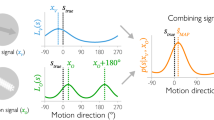Abstract
When we see motion, our perception of how one image feature moves depends on the behaviour of other features nearby. In particular, the Gestaltists proposed the law of shared common fate1,2, in which features tend to be perceived as moving together, that is, coherently. Recent psychophysical findings, such as the cooperativity of the motion system3,4 and motion capture5,6, support this law. Computationally, coherence is a sensible assumption, because if two features are close then they probably belong to the same object and thus tend to move together. Moreover, the measurement of local motion may be inaccurate7 and so the integration of motion information over large areas may help to improve the performance. Present theories of visual motion, however, do not account fully for these coherent motion percepts. We propose here a theory that does account for these phenomena and also provides a solution to the aperture problem8, where the local information in the image flow is insufficient to specify the motion uniquely.
This is a preview of subscription content, access via your institution
Access options
Subscribe to this journal
Receive 51 print issues and online access
$199.00 per year
only $3.90 per issue
Buy this article
- Purchase on Springer Link
- Instant access to full article PDF
Prices may be subject to local taxes which are calculated during checkout
Similar content being viewed by others
References
Ternus, J. Psychol. Forsch. 7, 81–136 (1926).
Kofika, K. Principles of Gestalt Psychology (Harcourt, Brace & World, New York, 1935).
Williams, D. W. & Sekuler, R. Vision Res. 24, 55–62 (1984).
Williams, D. W., Philips, G. & Sekuler, R. Nature 324, 253–255 (1986).
Mackay, D. M. Nature 192, 739–740 (1961).
Ramachandran, V. S. & Anstis, S. M. Vision Res. 23, 1719–1724 (1983).
Verri, A. & Poggio, T. Artifi. lntell. Memo 917, (MIT, Cambridge, 1986).
Marr, D. & Ullman, S. Proc. R. Soc. B211, 151–180 (1981).
Braddick, O. J. Phil. Trans. R. Soc. Lond. B290, 137–151 (1980).
Horn, B. K. P. & Schunk, B. G. Artif. Intell. 17, 185–203 (1981).
Hassenstein, B. & Reichardt, W. E. Z. Naturforsch. 11b, 513–524 (1956).
van Santen, J. P. H. & Sperling, G. J. opt. Soc. Am. A1, 451–473 (1984).
Adelson, E. H. & Bergen, J. R. J. opt. Soc. Am. A2, 284–299 (1985).
Ullman, S. The Interpretation of Visual Motion (MIT Press, Cambridge, 1979).
Grzywacz, N. M. & Yuille, A. L. AIP Conf. Proc. 151, (ed. Denker, J. S.) 200–205 (American Institute of Physics, New York, 1986).
Adelson, E. H. & Movshon, J. A. Nature 300, 523–525 (1982).
Anstis, S. M. Vision Res. 10, 1411–1430 (1970).
Ramachandran, V. S. & Anstis, S. M. Vision Res. 23, 83–85 (1983).
Hildreth, E. C. The Measurement of Visual Motion (MIT Press, Cambridge, 1983).
Poggio, T., Voorhees, H. & Yuille, A. L. Artifi. Intell. Memo 776, (MIT, Cambridge, 1984).
Bertero, M., Poggio, T. & Torre, V. Artifi. Intell. Memo 924, (MIT, Cambridge, 1987).
Ramachandran, V. S. & Inada, V. Spatial Vision 1, 57–67 (1985).
Yuille, A. L. & Grzywacz, N. M. Artifi. Intell. Memo 1002, (MIT, Cambridge, 1987).
Duchon, J. Lecture Notes in Math. 571, (eds Schempp, W. & Zeller, K.) 85–100 (Springer-Verlag, Berlin, 1979).
Nakayama, K. & Silverman, G. H. Invest. Ophthalmol. Vis. Sci. 26, 188 (1985).
Yuille, A. L. Artifi. Intell Memo 724, (MIT, Cambridge, 1983)
Little, J., Bulthoff, H. & Poggio, T. Proc. Image Understanding Workshop (ed. Baumann, L.) 915–920 (Science Applications International Corporation, McLean, Virginia, 1987).
Heeger, D. J. opt. Soc. Am. A4, 1455–1471 (1987).
Marr, D. Vision (Freeman, New York, 1982).
von Schiler, P. Psych. Forsch. 17, 179–214 (1933).
Author information
Authors and Affiliations
Rights and permissions
About this article
Cite this article
Yuille, A., Grzywacz, N. A computational theory for the perception of coherent visual motion. Nature 333, 71–74 (1988). https://doi.org/10.1038/333071a0
Received:
Accepted:
Issue Date:
DOI: https://doi.org/10.1038/333071a0
This article is cited by
-
Improving performance of robots using human-inspired approaches: a survey
Science China Information Sciences (2022)
-
A novel approach to the inspection of deformable bodies by adapting the coherent point drift algorithm and using a clustering methodology
The International Journal of Advanced Manufacturing Technology (2019)
Comments
By submitting a comment you agree to abide by our Terms and Community Guidelines. If you find something abusive or that does not comply with our terms or guidelines please flag it as inappropriate.



